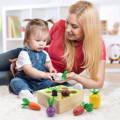Introduction to Montessori Toys: Why They Matter for Your 1-Year-Old

How Do 1-Year-Olds Play?
In their first year, kids really want to explore the world around them. Children use all of the five senses to understand their surroundings. This exploration results in many questions, such as:
- Is this object smooth or rugged?
- What happens when I release it from my hand?
- I wonder what does it taste like?
Of course, your child can’t express these thoughts - but trust us - they’re there. And as your child grows, their play tactics develop at the same time as their motor skills.

However, what you’ll find common in most 1-year-olds is that they enjoy solitary play. They’ll mostly be interested in their immediate surroundings and, of course, toys.
As for the other humans, only you and your closest family members come into the equation. Your 1-year-old won’t show much interest in other people or their peers. But that’s perfectly OK. It’s just a phase in their development.
But what they’ll do show interest in are toys. Therefore…
How Do Toys Affect Child Development?
Toys are more than mere playthings for your child. They provide emotional comfort to your child, and not only that, but they’re powerful learning tools as well.
No wonder so many kids play mainly with toys. Recent research on preschoolers indicates that 90% of their play incorporates toys in some way. When children play with toys, their brains undergo significant cognitive and linguistic growth.
During play, kids make up stories and events and act out things they see adults do. Playing helps children come up with new ideas and improve their language skills.

Playtime has a huge effect on a child's general development, not just cognitive. It also helps your child learn how to act in social situations. Through toys, they learn how to get along with others, understand what it means to share, and even solve problems.
What Toys Should Your 1-Year-Old Be Playing With?
Your child is developing quickly. Before you know it, they’ll make a leap from infancy to toddlerhood. During this transition, the importance of playtime can’t be stressed enough.
Playing gives children a chance to try out the new skills they've learned, which helps them learn more about the world around them.
According to Lisa Lohiser, EdD from the Fischer-Price Play Lab, playing with toys gives 12-month-olds an opportunity to unravel their identity and confront new challenges through trial and error.
In simple terms - playtime is really, really important. You definitely got it by now.
Given this developmental context, making sure your child has the right toys becomes more important than you initially thought. The toy selection must mirror your child’s evolving interests and motivate them to develop their personality further.
So, what toys should your youngest member of the family be playing with?
- Plush and stuffed toys that will help your child express their emotions and learn more about empathy.
- Toys that will challenge and enhance their growing motor skills: think stacking towers and push toys.
- Simple and sturdy musical instruments that will spark their creativity, like maracas and drum sets.

What to Look For in Toys for 12-Month-Olds?
Picking the right toys for a 1-year-old child is much more complicated than it was just a few decades ago. For starters, it’s a lot more expensive. Just in the last year, 95% of toy companies have increased their prices.
Also, there are more toys on the market than ever before. Given the number of options out there, picking the right toy for your child can be… more than overwhelming. If you’ve been having trouble selecting the right toy, here are some things you should pay attention to:
- Embrace movement: Did you know that the word "toddler" comes from the way they toddle and move? Your kid is getting more and more mobile, so it would be good to find toys that will keep them busy.
- Nurture fine motor skills: At 12 months, your child’s refined pincer grip allows them to pick objects more securely. That’s why toys with interactive elements like switches and lids are important during this period.
- Prioritize safety: Although your child is making big steps toward the “big kid” territory, toddlers still love to engage with their environment orally. You need to avoid toys with small parts that can accidentally end up in your child's throat.

Basically, you need toys that will motivate your child to move around and get their brain juices flowing, all while keeping them safe from choking hazards. Where can you find that?
Enter Montessori toys.
What Are Montessori Toys?
Montessori toys are made to help kids learn by doing, sparking their natural interest. The Montessori method is based on teaching children to think for themselves and putting a lot of focus on their physical and sensory development.

The Montessori method, named after its founder, Dr. Maria Montessori, originated in the early 20th century. Dr. Montessori was an Italian physician and educator who pioneered a revolutionary approach to education based on her observations of children's natural learning tendencies. She believed that children are naturally eager for knowledge and can thrive in a supportive, thoughtfully prepared environment.
Drawing from the Montessori philosophy, the characteristics that define these toys are:
- Simplicity
- Educational value
- Use of natural materials
- Realism
- Open-ended nature
- Promotion of independence
- Sensory stimulation
One of the standout features of Montessori toys is their construction from high-quality materials. That gives these toys longevity, making them a cost-effective choice for parents.
The focus is always on encouraging a child's natural curiosity and making sure they really get into their play so they can learn as much as possible from each playtime session.
How Do Montessori Toys Benefit Children?
Kids don't just play for fun. When they're playing, they're also learning, like little scientists testing out their ideas. Montessori toys, sometimes called 'smart toys,' are built on this idea. Instead of just entertaining kids, they help them learn essential life skills.
Here are some of the benefits of Montessori toys:
- Improving movement and awareness: These toys can help kids with their hand-eye coordination. They get to practice moving and understanding where things are in space.
- Making kids think: Montessori toys help engage kids' brains. They learn to solve problems, remember things, and make decisions. Just think about a puzzle. To finish it, kids need to think hard and plan their moves.
- Understanding emotions: Some toys help kids explore feelings. They can learn about being happy, sad, or frustrated and how to handle those feelings.
- Getting along with others: Montessori toys also teach kids about being with friends. Through play, they learn about sharing, patience, and even leadership. This is super important for when they start school and later in life.
- Staying focused: Some games need kids to really focus. This helps them better pay attention, which always comes in handy.
- Boosting creativity: Lastly, Montessori toys help kids' imaginations soar. They learn to think creatively and see things in new ways. That can give them confidence and make them feel like they can make a difference.

Research published in the Journal Frontiers in Psychology claims that Montessori education can lead to more creative people. So, by choosing Montessori toys, you're giving your child tools that help them grow in every way.
What Toys are ACTUALLY Montessori?
Montessori is not actually a brand. It’s a teaching method that helps children reach their full potential naturally. Go to your local toy store, and you’ll find loads of items calling themselves Montessori. While some of them fit the idea, you probably want something that will really engage your child.
That’s why the Montessori Generation is here for you. Every product we offer is right in line with Montessori ideas and is designed with 1-year-olds in mind. Some of the Montessori toys for 1-year-olds we offer include:
- Object Permanence Box: A simple toy that catches attention. Kids love the bright red ball and want to find out how to play with it. It's great for thinking and understanding space.
- Shape Blocks: Everyone knows and loves shape blocks. The Montessori version is just the right size and feel. Children can work on their hand muscles as they pick up and place the shapes.
- Vegetable Set: Like the shape blocks, this toy helps with hand movements. But it also has fun details that make kids use that special pinch they start to do around one year old.

How to Introduce Your Child to Montessori Toys?
So, you've got a brand-new box of Montessori toys. Exciting! But you’re not sure your kid will embrace them right away. No worries. Just give them some time, and they’ll love it.
If you want to help them get familiar with their toys, here’s how to do it in four simple steps:
- Keep it simple: When showing a new toy, use fewer words. It's easier for kids that way. Show them how it works rather than telling them.
- Show the way: If your child is struggling and asks you for help, show them how to use the toy. This isn't just about telling; it's about doing. Sit with them and play a bit so they can watch and learn.
- Share the turn: After you've demonstrated, let them try. But remember, be patient. If they start using the toy in a way it's not meant for (like throwing), gently guide them. For instance, "This isn't for throwing. How about we throw this ball instead?"
- Do it again... and again: Kids love to repeat things. It's how they learn best. So, let them play with the same toy many times. They might even find new ways to play with it each time.
Remember, Montessori is all about learning through play. It's a journey, not a race. So, let your child explore, learn, and, most importantly, have some much-needed fun.
Conclusion
With its century-long history, the Montessori method offers a natural approach to children’s education and early development. Using educational toys based on the Montessori method can enhance brain development, problem-solving, and communication skills in young children.
As a parent or caregiver, it’s important to stay informed and select toys that align with these principles. If you’re interested in Montessori toys for 1-year-old, don’t hesitate to get in touch. Feel free to contact us today and get your child’s favorite new toys.
Free Delivery
Over $80
Easy Returns
No questions asked
Unbeatable Warranty
1-year ++ warranty
- Secure CheckoutWorld’s most secure payment method




